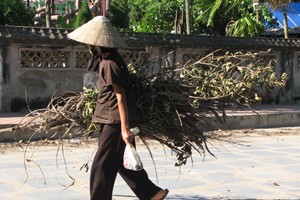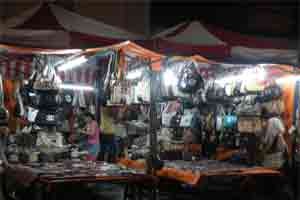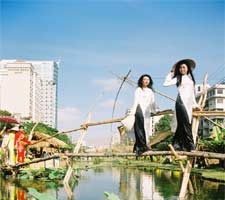Lung Cu Commune is known as the ceiling of Vietnam, but a visit to this border area means more than climbing mountains and enjoying the view from the top.

I am standing at the 422nd milestone in the small village of Seo Lung, and I can experience the true grandeur of the place.
The late morning sunlight seemed to flow like a river along a mountainside to color it amber, and in the distance, green corn fields tried to balance the bright and the dark with its cool shade. The whole picture became animated suddenly as the wind moved the corn crop to do a belly dance in unison from the top to the bottom of the mountain.
The late morning sunlight seemed to flow like a river along a mountainside to color it amber, and in the distance, green corn fields tried to balance the bright and the dark with its cool shade. The whole picture became animated suddenly as the wind moved the corn crop to do a belly dance in unison from the top to the bottom of the mountain.
My guide, a border guard, asked me to stretch my view to the opposite side and behold the Su Tu Son (Mountain Lion) mountain range. It was awe inspiring indeed! I could not bring myself to turn away from the waves of mountains receding into the horizon until he tugged gently and pointed me to a dark red path that ran zigzag into a Chinese hydroelectricity project that was under construction.
On the way down, the guard confided that he had previously picked a piece of stone from here to place on his ancestral altar. This is expected to bring eternal peace and amity between all Vietnamese residents.
It seemed that there was no hot weather here; we constantly felt the cool breeze teasing us in a friendly manner. The path was quite a steep incline, but obviously that could not stop us going ahead, discovering plenty of wild flowers blooming on both sides.
I was impressed with the cultivation technique of the residents here because they were farming on terrain that was full of stones and hard soil. It’s hard to believe what I could see, but it seems that all the plants here had the strength and vitality to break the soil and grow up.
We also visited a pre-school before reaching the bottom of the mountain. The school had been provided with enough facilities to offer an improved learning environment to its wards. A young female teacher affirmed that the school’s standards had improved over a few years. The good news took some of the tiredness out of us.

After just half a day in Seo Lung, I could see a lot of improvement. Projects 134 and 135 designed to help ethnic minorities had brightened the picture in this village. Houses had become more solid with cement walls and corrugated iron roofs. Residents were more conscious of the need to keep clean water, had begun to invest in new high-yield corn varieties and every house seemed to have enough food to store for lean times.
Late in the evening, we could hear a cheerful, rhythmic combination of various birds chirping. Families here make cages and hang them in front of the house to invite pigeons or swallows to set up their homes.
Visitors would be missing something if they did not look into the housing culture of the H’mong minority people. They have used the same techniques for hundreds of years – and first time guests cannot fail to be charmed by the mud walls, stone fences and thatched roofs.
When the sun went down, a young male teacher took me to Ta Giao Khau, another small village about 6 kilometers away from the center of Lung Cu. Ta Giao Khau consists of 90 H’mong families living beside their terraced fields. The families here also possess a technique to cultivate corn in small caves in the mountain. The chief of this village, Tho Sin Cho, was very happy to share with us the news that his village had clean water, and that there was no poor family in the village since they learnt how to apply new cultivation techniques for their crops and for raising livestock.
Now, the house of culture has become the first entertainment choice for all residents every night, thanks to the advent of electricity. The house was also used to stage performances and hold cultural exchanges with neighboring villages.
The transformation from day to night here is very fast, I easily recognized after a day’s visit. While preparing to sleep, I was suddenly drawn by a variety of sounds from various instruments like the two-chord fiddle, Pi Le trumpet (played by Thai and Tay minorities) and the Khen Be trumpet.
“This is a rehearsal of a local amateur music band preparing for a show tomorrow to entertain guests from the north,” my host informed me, smiling.
Lung Cu is a 3460-hectare commune on the Vietnamese border with China, with a population of 3,051 residents in 503 families. Residents are mostly from the H’mong and Lo Lo minorities. They usually grow rice on terraced fields, and plant corn on flat land. The Lo Lo have still preserved their traditional weaving techniques.
Quite different to the previous bad image that dangerous pathways, biting wind with also snow and poor lives of the minority families, now, Lung Cu has seen its brighter day with happiness and better improvements. Officials directed the constructing teams to spread asphalt on the pathways and bring the electricity to the area to light up everything here.
Guests once visiting this area obviously are highly recommended to visit the national flag tower on the Rong (Dragon) Mountain. The tower which motifs the Ha Noi flag tower has a height of approximately 20 meters. Its sole was carved with Designs on Dong Son brass ware in all six sides. The 54-meter-in-width flag keep flying round the tower easily reminds guests of the freedom of the country. And please remember do not leave some spots like Lo Lo Lake or Si Man Khang Carve in the Rong Mountain out of list.
According to some local residents, the name Lung Cu has various origin tales. Someone said it originated from the name Long Cu (the place where dragon lives) or Lung Ngo while someone else said it is the name of the leader of Lo Lo minority, who found and changed waste land into the current cultivated area. However, many people believe in another origin that Lung Cu originated from the name Long Co (Dragon’s Drum).
Many years ago, Lo Lo minority had a culture that they make the Lo Lo’s traditional clothes for the dead persons as they believe that dead persons if not wearing the traditional clothes would not be accepted by the ancestors at the heaven.
Besides the kettle drum, the Lo Lo minority also has preserved variety of historic items which firstly appeared since the Hung Vuong Dynasty.
Lung Cu Commune consists of 9 small villages namely Lo Lo Chai, Seo Lung, Ta Giao Khau, Can Tang, Then Van, Then Pa, Si Man Khan, San Cho, San Sa Phin. Known as the highest place of Viet Nam, most places in Lung Cu Commune have the height around 1,600-1,800 meters above the water level.
A short trip to Lung Cu gave me a lot of unforgettable memories, especially some local specialties such as “San” tea, honey alcohol, flowers of pearl, local kemis, “dan moi” – an instrument is played by lip, H’mong’s pan-pipe and also the sound of kettle drum beside the fire in the village.
Late in the evening, we could hear a cheerful, rhythmic combination of various birds chirping. Families here make cages and hang them in front of the house to invite pigeons or swallows to set up their homes.
Visitors would be missing something if they did not look into the housing culture of the H’mong minority people. They have used the same techniques for hundreds of years – and first time guests cannot fail to be charmed by the mud walls, stone fences and thatched roofs.
When the sun went down, a young male teacher took me to Ta Giao Khau, another small village about 6 kilometers away from the center of Lung Cu. Ta Giao Khau consists of 90 H’mong families living beside their terraced fields. The families here also possess a technique to cultivate corn in small caves in the mountain. The chief of this village, Tho Sin Cho, was very happy to share with us the news that his village had clean water, and that there was no poor family in the village since they learnt how to apply new cultivation techniques for their crops and for raising livestock.
Now, the house of culture has become the first entertainment choice for all residents every night, thanks to the advent of electricity. The house was also used to stage performances and hold cultural exchanges with neighboring villages.
The transformation from day to night here is very fast, I easily recognized after a day’s visit. While preparing to sleep, I was suddenly drawn by a variety of sounds from various instruments like the two-chord fiddle, Pi Le trumpet (played by Thai and Tay minorities) and the Khen Be trumpet.
“This is a rehearsal of a local amateur music band preparing for a show tomorrow to entertain guests from the north,” my host informed me, smiling.
Lung Cu is a 3460-hectare commune on the Vietnamese border with China, with a population of 3,051 residents in 503 families. Residents are mostly from the H’mong and Lo Lo minorities. They usually grow rice on terraced fields, and plant corn on flat land. The Lo Lo have still preserved their traditional weaving techniques.
Quite different to the previous bad image that dangerous pathways, biting wind with also snow and poor lives of the minority families, now, Lung Cu has seen its brighter day with happiness and better improvements. Officials directed the constructing teams to spread asphalt on the pathways and bring the electricity to the area to light up everything here.
Guests once visiting this area obviously are highly recommended to visit the national flag tower on the Rong (Dragon) Mountain. The tower which motifs the Ha Noi flag tower has a height of approximately 20 meters. Its sole was carved with Designs on Dong Son brass ware in all six sides. The 54-meter-in-width flag keep flying round the tower easily reminds guests of the freedom of the country. And please remember do not leave some spots like Lo Lo Lake or Si Man Khang Carve in the Rong Mountain out of list.
According to some local residents, the name Lung Cu has various origin tales. Someone said it originated from the name Long Cu (the place where dragon lives) or Lung Ngo while someone else said it is the name of the leader of Lo Lo minority, who found and changed waste land into the current cultivated area. However, many people believe in another origin that Lung Cu originated from the name Long Co (Dragon’s Drum).
Many years ago, Lo Lo minority had a culture that they make the Lo Lo’s traditional clothes for the dead persons as they believe that dead persons if not wearing the traditional clothes would not be accepted by the ancestors at the heaven.
Besides the kettle drum, the Lo Lo minority also has preserved variety of historic items which firstly appeared since the Hung Vuong Dynasty.
Lung Cu Commune consists of 9 small villages namely Lo Lo Chai, Seo Lung, Ta Giao Khau, Can Tang, Then Van, Then Pa, Si Man Khan, San Cho, San Sa Phin. Known as the highest place of Viet Nam, most places in Lung Cu Commune have the height around 1,600-1,800 meters above the water level.
A short trip to Lung Cu gave me a lot of unforgettable memories, especially some local specialties such as “San” tea, honey alcohol, flowers of pearl, local kemis, “dan moi” – an instrument is played by lip, H’mong’s pan-pipe and also the sound of kettle drum beside the fire in the village.
























